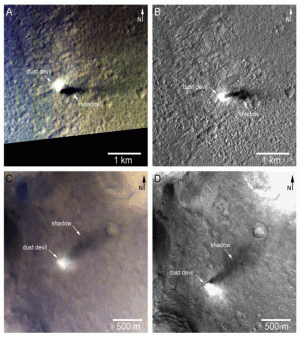Extending earlier work, a team of Mars scientists led by Dennis Reiss (Westfälische Wilhelms-Universität, Germany) has made simultaneous (or near-) observations of dust devil speeds using cameras on NASA’s Mars Reconnaissance Orbiter. The cameras include CRISM, CTX, and HiRISE. The data run from 2008 to 2011, and the results are published in Icarus.

SPEED CAMERA. Simultaneous imaging by CRISM (left side) and CTX let scientists measure the size and speed of dust devils. The A-B pair shows a dust devil moving southeast at 12.3 meters/sec (28 mph), while in the C-D pair, the measured speed is 16.8 m/s (38 mph) to the south. (Image taken from Figure 4 in the paper.)
The team identified a total of 47 dust devils in 15 regions. Most were in the northern hemisphere, and a majority of those were in Amazonis Planitia. The main time of year they appeared was early to mid northern spring.
The dust devils had diameters ranging from 15 to 280 meters (49 to 920 feet) with an average diameter of 100 m (330 ft). Heights were 40 to 4400 m (130 to 14,400 ft). Horizontal speeds ranged from 4 to 25 m/sec (9 to 56 mph), with an average of 12 m/sec (27 mph).
Comparisons between the measured dust devil ground speeds and near-surface
wind speed predictions derived from models suggest that dust devils move
about twice as fast as Martian surface winds actually blow. What appears to be the controlling element is the motion of the planetary boundary layer. This is the layer in the atmosphere that extends from the ground up to about 5 km (3 mi) altitude. Scientists think it moves faster because most of it lies high enough to be free of friction with the surface.
The goal of the research, the scientists say, is both general and specific. “Our new introduced method for measuring horizontal speeds and directions of dust devils with MRO instruments offers future perspectives to better understand dust devil processes on Mars, using, for example, near-surface wind speed measurements at the current Mars Science Laboratory (MSL) landing site in Gale Crater.”








